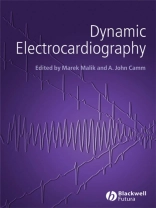Two well-known and respected editors have assembled an outstanding group of electrophysiologists/physicians to write a major work representing the field of electrocardiography as we know it today. This book contains all the major subject areas within the field of electrocardiography with significant clinical and basic content to appeal to the entire electrophysiology community in addition to educating cardiologists with the latest information. The fact that Drs. Malik and Camm have edited this work assures a volume of incredible quality and readability.
Cuprins
Section 1: Heart Rate Variability.
1. Physiologic Background.
2. Standard Measurement of Heart Rate Variability.
3. Nonlinear Dynamics of R-R Intervals.
4. Correlations among heart rate variability: Components andautomatic mechanisms.
5. Physiological Understanding of HRV Components.
6. Automatic Balance.
7. Heart Rate Variability: Stress and psychiatricconditions.
8. Circadian Rhythm of Heart Rate and Heart Rate Variability.
9. Time-frequency Analysis of Heart Rate Variability under Automatic Provocations.
10. Effects of Drugs.
11. Heart Rate Variability in Healthy Populations: Correlatesand Consequences.
12. Heart Rate Variability in Ischemic Disease.
13. Heart Rate Variability in Heart Failure.
14. Heart Rate Variability in Diabetes and Neuropathies.
Section 2: Baroreflex.
15. Baroreflex: Physiologic Background.
16. Invasive Determination of Baroreflex Sensitivity.
17. Noninvasive Provocations of Baroreflex Sensitivity.
18. Analysis of the Interactions between Heart Rate and Blood Pressure Variabilities.
19. Arterial Baroreflexes in Ischaemic Heart Disease, and theirrole in sudden cardiac death.
20. Heart Rate Turbulence on Holter.
21. Heart Rate Turbulence in Pacing.
22. Physiologic Hypotheses on Heart Rate Turbulence.
23. Heart Rate Trbulence in Ischemic Heart Disease.
Section 3: Ischaemic Patterns.
24. Electrocardiographic Background.
25. Dynamics of Silent Ischaemia.
26. Dynamics of ST Segments in Ischaemic Heart Disease.
27. Spatial Patterns of ST-Segment Shift During Myocardial Ischaemia.
28. ST Segment Trend Monitoring of Acute Chest Pain Patients.
29. Circadian Patterns of Ischaemic Episodes.
30. Electrocardiographic Findings in Patients with Cardiovascular Syndrome X.
Section 4: Ventricular Repolarisation.
31. Cellular Basis for the Repolarization waves of the ECG.
32. Individual QT/RR Relationships.
33. Circadian Patterns of QTC Interval.
34. QT Dispersion.
35. Morphological Assessment of T Wave Patterns.
36. Circadian Pattern of T Wave Morphology.
37. QT Interval Dynamics During Exercise.
38. T Wave and QT Interval Changes Related to Myocardial Ischaemia.
39. Influence of Rhythm Abnormalities on Ventricular Repolarisation.
40. Dynamics of Acquired Long QT Syndrome.
41. Electrocardiogram of Brugada Syndrome and its Dynamic Pattern.
42. Electrocardiographic T Wave Changes in Left Ventricular Hypertrophy.
43. Macro T Wave Alternans.
44. Microscopic T Wave Alternans.
45. T Wave Alternans in Ischaemic Heart Disease.
46. Dynamic Repolarization Changes and Arrhythmia Assessment.
Section 5: Atrial Fibrillation.
47. Pathophysiology of the Atrial Fibrillation Electrogram.
48. P Wave Abnormalities Prior to AF Episodes.
49. Dynamics of Atrial Electrogram AF.
50. Detection of Paroxysmal Atrial Fibrillation Episode.
51. Circadian Pattern of AF Paroxysms.
52. Monitoring after Cardioversion of Atrial Fibrillation.
53. Heart Rate Profile in Chronic Atrial Fibrillation.
54. Monitoring Heart Rate Control in Atrial Fibrillation.
55. Autonomic Influence of Atrial Fibrillation.
56. Long Time Monitoring of Cardiac Rhythm in Patients with Atrial Fibrillation.
Section 6: Ventricular Arrhythmias.
57. Monitoring Ectopic Activity.
58. Circadian Pattern of Arrhythmic Episodes.
59. Holter Monitor-Guided Antiarrhythmic Therapy.
60. Dynamics of Heart Rate Prior to Arrhythmias.
61. Technical Considerations.
62. Ischaemic Patterns.
63. State of the Art Marker Channels.
64. Interpretation of Device Stored Rhythms and Electrocardiograms
Despre autor
Prof. Marek Malik, Ph D, MD, DSc, FACC. Professor of Cardiac
Electrophysiology, St. George’s Hospital Medical School
Prof. A. John Camm, QHP, MD, FRCP, FESC, FACC. Professor of
Clinical Cardiology, St. George’s Hospital Medical School












